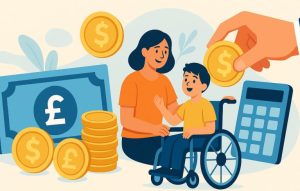Navigating the Universal Credit system can be overwhelming, especially for parents who are caring for a disabled child. Many parents in the UK find themselves unsure of where to start when applying for additional financial support.
For families who rely on benefits, understanding what is available and how to claim it can make a significant difference in their quality of life.
This guide will walk through what the Disabled Child Element is, who can claim it, and how to navigate the process confidently.
With a clear explanation of eligibility, payment structures, and other support options, this blog aims to simplify the complex rules and make it easier for families to access the help they need.
What Is Disabled Child Element In Universal Credit?

The Disabled Child Element is an additional amount provided within Universal Credit to support families caring for a child with a recognised disability. This extra financial support is crucial for covering the costs associated with raising a child who has additional needs.
Universal Credit, by itself, is a monthly benefit payment intended to assist with living expenses. The Disabled Child Element is one of the extra components that can be added to a Universal Credit payment when a child meets certain disability criteria. It is paid regardless of the number of children in the household.
Understanding The Purpose Of The Disabled Child Element
The primary goal of this support is to ease financial pressure on families who often face higher costs linked to specialist care, equipment, or therapies. The extra amount helps balance the gap for parents who may need to reduce working hours to care for their child.
Who Can Qualify For The Disabled Child Element?
Eligibility for the Disabled Child Element is mainly based on the child’s disability status and the benefits they already receive. Understanding these conditions is essential before starting the application process.
Age And Educational Requirements
The child must live with the applicant and can receive support up to the 31 August following their:
- 16th birthday
- 19th birthday if they are in approved education or training, including GCSEs, A-Levels, BTECs, or similar qualifications
This extended support ensures that teenagers who are still in school or college can continue receiving the financial help they need.
Disability Benefits Required For Eligibility
To qualify, the child must be in receipt of:
- Disability Living Allowance (DLA) at any rate of care or mobility
- Personal Independence Payment (PIP) at any rate of daily living or mobility
The amount of the Disabled Child Element depends on the benefit level. For example, if the child gets the highest care component of DLA or enhanced daily living of PIP, the higher payment rate applies.
Additional Eligibility Points
- The applicant must be claiming Universal Credit.
- The child must normally live with the applicant.
- The Department for Work and Pensions (DWP) must be informed of the child’s disability benefit award.
The eligibility is not limited to the first two children, unlike the general child element in Universal Credit. Families can receive the Disabled Child Element for all children who qualify.
How To Claim Disabled Child Element Universal Credit?

Claiming the Disabled Child Element involves a few key steps, but the process can be straightforward if handled carefully.
Step 1: Apply For Universal Credit
The claim must start with an application for Universal Credit through the GOV.UK online portal. It is essential to provide accurate information about the household, including details about all dependent children.
Step 2: Declare The Child’s Disability
When making a Universal Credit claim, there is a section to declare if any dependent child receives Disability Living Allowance or Personal Independence Payment. Supporting documents, such as award letters from DLA or PIP, may be required to confirm eligibility.
Step 3: Update Changes Promptly
It is vital to report any changes, such as new benefit awards or the end of a child’s disability payment, as soon as possible. Delays in reporting may result in incorrect payments or potential overpayments.
Step 4: Backdating Claims
If there was a delay in claiming, families may be able to request backdating for up to one month, or potentially longer in certain circumstances. Backdating depends on when the child became eligible for the disability benefit.
Step 5: Managing The Claim Online
The Universal Credit online account allows claimants to track their payments, submit changes, and communicate with their work coach.
Key Notes:
- The carer’s element is not automatically included even if Carer’s Allowance is being claimed. It must be reported separately.
- The child disability element continues while the child is in approved education up to age 19.
What Is The Payment Structure For Universal Credit?
Universal Credit payments are made monthly and include several possible elements that depend on the household situation.
Standard Allowance Rates
The basic monthly amounts for 2025 are:
| Household Situation | Monthly Standard Allowance |
| Single under 25 | £316.98 |
| Single 25 or over | £400.14 |
| Couple both under 25 | £497.55 |
| Couple one or both over 25 | £628.10 |
Extra Elements That Can Be Added
Universal Credit can include additional elements based on specific circumstances:
- Child elements
- Disabled child elements
- Carer’s element
- Childcare support
- Housing support
- Disability or health condition support
It is important to note that these elements are not automatically added. Families must inform the Department for Work and Pensions (DWP) about their eligibility for extra payments.
Other Considerations
- Payments may be reduced by deductions for overpayments or advances.
- Income from work, savings, or other benefits may also affect the total amount.
How Much Can You Get For A Disabled Child?

Families with disabled children may receive significant additional support depending on their child’s level of need.
Payment Rates For 2025
| Type of Support | Extra Monthly Amount |
| Lower Rate | £158.76 |
| Higher Rate | £495.87 |
The lower rate applies if the child is receiving Disability Living Allowance (DLA) or Personal Independence Payment (PIP) at basic levels. The higher rate is for children on the highest care component of DLA or the enhanced daily living part of PIP.
Additional Child Elements
Universal Credit also provides a child element for children living in the household:
- £339 per month for the first child born before April 2017
- £292.81 per month for the first child born on or after April 2017
- £292.81 per month for the second child and eligible additional children
Families can claim for all disabled children, even beyond the usual two-child limit.
Can You Receive Other Elements Like Carer’s Or Childcare Support?
Universal Credit offers further financial help through the carer’s element and childcare support.
Carer’s Element Eligibility
A carer’s element can be added if the claimant provides care for someone receiving a qualifying disability benefit. The care must be for at least 35 hours per week.
The carer’s element for 2025 is £201.68 per month. Only one payment is made per cared-for person, even if two people share the caring responsibilities.
Childcare Cost Support
Families can claim up to 85% of childcare costs if they are working. Both partners must be working unless one cannot work due to a disability.
The maximum monthly childcare support is:
- £1,031.88 for one child
- £1,768.94 for two or more children
The childcare provider must be registered, and costs need to be paid upfront before reclaiming them through Universal Credit.
How Does Income Or Savings Affect Your Payment?

Universal Credit payments are adjusted based on earnings, other income, and savings.
Impact Of Savings
If a household has more than £6,000 in savings, their Universal Credit payment will be reduced by £4.35 for every £250 over this threshold. No payment is made if savings exceed £16,000.
| Savings Amount | Reduction in Universal Credit |
| £6,000 – £16,000 | £4.35 reduction per £250 |
| Over £16,000 | Universal Credit stopped |
Deductions From Universal Credit
Payments may be reduced if:
- The claimant is repaying an advance payment.
- The benefit cap applies.
- Overpayments or debts such as council tax arrears are being recovered.
Income from work and some other benefits will also reduce Universal Credit. For example, Carer’s Allowance and Armed Forces Pensions are deducted from the payment.
What Happens When You Move To Universal Credit From Other Benefits?
When moving from legacy benefits to Universal Credit, claimants may receive additional protection.
Two-Week Run-On Payments
Claimants who are switching to Universal Credit can receive two additional weeks of their previous benefit payments if they were claiming:
- Income-based Jobseeker’s Allowance
- Income-related Employment and Support Allowance
- Income Support
- Housing Benefit
These payments help ease the transition and do not need to be repaid.
Transitional Protection
Some people may qualify for transitional protection if they have been moved to Universal Credit after receiving a Migration Notice. This protection helps to prevent a sudden drop in benefit income.
What Other Financial Support Is Available?

Universal Credit recipients may be able to access other types of support.
- Housing Support: Universal Credit can help with rent or certain service charges. Homeowners may qualify for a loan to help cover mortgage interest.
- Budgeting Advances: Short-term financial help is available for emergency expenses. These advances must be repaid through future Universal Credit deductions.
- Health-Related Support: People with limited capability for work or work-related activity can receive an extra amount each month. For 2025, this is £423.27.
If the claimant started their health-related Universal Credit or ESA claim before April 2017, they may be entitled to £158.76 each month.
Conclusion
Understanding how to claim the Disabled Child Element of Universal Credit can make a meaningful difference in the lives of many UK families. The extra financial support can help cover the additional costs of caring for a disabled child and relieve some of the financial burden faced by parents and carers.
From learning about eligibility, payment structures, and how to make a successful claim, this guide has aimed to simplify what can be a complex system. Taking timely action, staying informed, and providing accurate information throughout the claim process are key to ensuring that families receive the correct support.
Universal Credit is not a one-size-fits-all system, but it offers valuable assistance to those who need it most when the correct steps are followed.
FAQs About Disabled Child Element Universal Credit
How Long Does It Take To Process A Disabled Child Element Claim?
Processing times can vary, but most Universal Credit changes are reflected within one assessment period, typically within a month.
Can You Claim For More Than One Disabled Child?
Yes, families can receive the Disabled Child Element for each child that qualifies, regardless of how many children they have.
Do Savings Affect The Disabled Child Element?
Savings over £6,000 will reduce Universal Credit payments, but there is no specific savings limit for the disabled child element itself.
Can You Claim Carer’s Allowance And The Disabled Child Element Together?
Yes, but the carer’s element must be claimed separately on Universal Credit, and you cannot get both the limited capability for work element and the carer’s element at the same time.
Is The Disabled Child Element Automatically Applied?
No, families must report their child’s disability and provide evidence for the extra element to be included in their Universal Credit payment.
Can Childcare Costs Be Claimed For A Disabled Child?
Yes, families can claim up to 85% of childcare costs for disabled children if they meet the work criteria.









